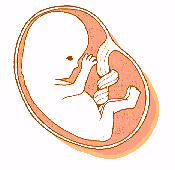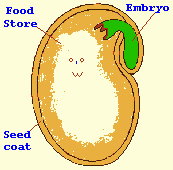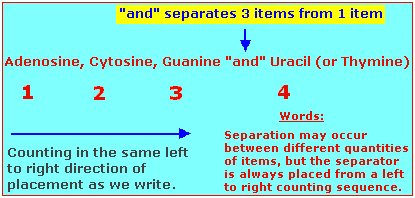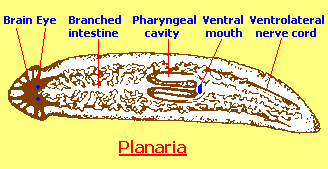page 3
(The Study of Threes)
http://threesology.org
Visitors as of 11/18/2019
| Pages in the Biological & Physiological 3s Series: | ||
| B/P 3s pg. 1 | B/P 3s pg. 2 | B/P 3s pg. 3 |
| B/P 3s pg. 4 | B/P 3s pg. 5 | B/P 3s pg. 6 |
| B/P 3s pg. 7 | B/P 3s pg. 8 | B/P 3s pg. 9 |
| B/P 3s pg. 10 | B/P 3s pg. 11 | The Devil's Advocate and 3s Research |
Zoologists have noted many triads within the human body. It would seem as if every important function of an organism possesses this basic structure. Such observations illustrate the fundamental meaning of the triad as the living wholeness of types of relationship within a complex single structure. It is a mark simultaneously of a being's unique identity and of its internal multiplicity, of its relative stability and of the mobility of its components, of its immanent independence and of its dependence. The triad is as useful a channel of dialectic in the logical exercise of thought as of movement in physics and of living matter in biology. The basic rationale of this universal phenomenon of threes must no doubt be sought in a metaphysics of composite and contingent being and in a global view of the manifold oneness of being - appearance, development and destruction (or transformation); or birth, growth and death; or again, in Astrological tradition, increase, culmination and decrease. Jean Chevalier & Alain Gheerbrant |
3 types of sleep apnea (unable to breathe):
Obstructive sleep apnea- is caused by a blockage of the airway, usually when the soft tissue in the rear of the throat collapses and closes during sleep.
Central sleep apnea- the airway is not blocked, but the brain fails to signal the muscles to breathe.
Mixed sleep apnea, as the name implies, is a combination of obstructive sleep apnea and central sleep apnea.
http://www.al.com/news/birmingham/May2000/2-e413032b.html
| Whey | 3 distinct types: A. Hydrolyzed Whey Protein Isolate (HWPI) B. Whey Protein Isolate (WPI) C. Whey Protein Concentrate (WPC) |
| Has one of the highest P.E.R. (Protein Efficiency Ratio) at 3.9 | |
| Low in fat, calories and cholesterol |
http://www.bodybuildersnetwork.com/bmuscle/
- Pericarditis- Inflammation of the
pericardium
- Acute serofibrinous pericarditis- the result of virus infection
The tissue damage is the result of:
- Direct cellular damage by the infecting virus
- Destruction of viral-infected cells by sensitized T-lymphocytes
- Antibody-dependent, cell-mediated cytotoxicity (null cell-dependent).
- Acute purulent pericarditis- due to bacterial infection (except for Mycobacterium tuberculosis)
The tissue damage is the result of:
- Toxin and enzyme production by the bacteria
- Myocardial damage
- Rapidly progressing cardiac tamponade
- Chronic pericarditis - due to infection by M. tuberculosis or fungi
The early granulomatous stages are associated with:
- Large pericardial effusions (> 300 ml)- that are typically...
- Serosanguinous- and contain a predominance of...
- Mononuclear cells.
- Myocarditis- Inflammation of the heart muscle
- Endocarditis- Inflammation of the endocardium
Triphasic sound that resembles scratching or the crunch of footsteps on cold snow is called the Pericardial friction rub and is a symptom of acute serofibrinous pericarditis.
3 ways in which Myocardial cell damage may occur:
- Direct viral damage- (e.g., with the Coxsackie B virus).
- Inhibition of humoral and macrophage-mediated immunity early in the infection.
- T-cell mediated cell lysis late in the disease.
3 Respiratory tract manifestations of (Myocarditis) viral infections in older children and adults:
- Moderate fever
- Cough
- Coryza
3 Abdominal manifestations of (Myocarditis) viral infections in older children and adults:
- Pain
- Nausea
- Vomiting
3-patterned manifestation of Myocardial involvement in Abnormal laboratory findings:
- Increased sedimentation rate
- Increased leukocyte count
- Increased myocardial isoenzymes
- Serum Glutamic Oxaloacetic Transaminase (SGOT)
- Creatinine Phosphokinase (CPK)
- Lactic Dehydrogenase (LDH)
3 most common bacteria infecting the pericardium:
- The pyogenic cocci Staphylococcus
- Streptococcus
- Neisseria
3 compounds (listed in order from most effective to least efficacious) used in the treatment of infection in myocardial infarction:
- Macrolide antibiotics (erythromycin, azithromycin, clarithromycin)
- Tetracyclines
- Fluoroquinolones (ciprofloxacin, norfloxacin and ofloxacin)
http://www.kcom.edu/faculty/chamberlain/Website/tritzid/carditis.htm
3rd month of human pregnancy looks similar to a bean, providing us with the humourous notion that the different races of humanity evolved from white beans, red beans, black beans, brown beans, yellow beans, Mexican jumping beans, jelly beans, etc...
 --- Care During Pregnancy --- |
 --- BBC Education --- |
http://www.evesindia.com/family/baby-pregnancy/monthwiseguide3.html
BBC Education
3 types of lactase deficiency: Congenital ~ Acquired ~ Temporary.
3 items produced by bacterial fermentation of Lactose in the
large intestine: Carbon dioxide ~ Hydrogen ~ Methane.
This in
turn leads to Bloating ~ Cramping ~ Flatulence (passing gas).
http://health.discovery.com/diseasesandcond/encyclopedia/2712.html
3 main types of feline leukemia virus (FeLV): FeLV-A ~ FeLV-B ~ FeLV-C.
FeLV-positive cats can be infected with one, two, or all three types:
FeLV-A occurs in all FeLV-infected cats and causes severe immunosuppression (weakened immune system).
FeLV-B occurs in about 50% of all FeLV-infected cats and causes more neoplastic disease (i.e., tumors and other abnormal tissue growths) than cats infected only with FeLV-A.
FeLV-C occurs in about 1% of FeLV-infected cats and causes severe anemia.
http://www.animalhealthchannel.com/FeLV/
3 degree temperature variation in adults with the influenza (Flu) illness: usually 100ºF to 103ºF (and often even higher in children).
3 types of Influenza viruses: A ~ B ~ C.
3 categories of Influenza strains included in each year’s influenza vaccine: A(H1N1) ~ A(H3N2) ~ B.
3 major pandemics of Influenza in the 20th Century:
1918-19 "Spanish flu" A(H1N1)- Caused the highest known influenza-related mortality: approximately 500,000 deaths occurred in the United States, 20 million worldwide. (A child's rhyme at the time was: I had a bird whose name was enza, I opened up a window, and "in flew enza".)
1957-58 "Asian flu" A(H2N2)- 70,000 deaths in the United States.
1968-69 "Hong-Kong flu" A(H3N2)- 34,000 deaths in the United States.
http://www.cdc.gov/ncidod/diseases/flu/fluinfo.htm
3 types of cataracts: Nuclear ~ Cortical ~ Posterior subcapsular
http://nutrition.tufts.edu/feature/cataracts.shtml
3 to 1 ratio of the so-called four layers or tunics of the G.I. tract:
1 of 3 (non-muscle)- Mucosal (Muscularis Mucosa is a thin muscle layer)
2 of 3 (non-muscle)- Submucosa
3 of 3 (non-muscle)- Adventitia
1 of 1 (muscle)- Muscularis
Various 3-patterned references:
- 3 general major parts to the oral cavity: Teeth ~ Tongue ~ Cheeks.
- 3-patterned (or 3 to 1 ratio) perspective of the so-called four different kinds of teeth: Pre-Molars/Molars ~ Canine ~ Incisors
- 3 references to deciduous teeth: Baby teeth ~ Milk teeth ~ Primary teeth.
- 3 roots and 1 root teeth occur in deciduous (baby teeth)...1st set of teeth.
- 3 roots, 2 roots, and 1 root teeth occur in permanent teeth...2nd set of teeth.
- 3rd set of teeth (called false teeth/partials) have no roots.
- 3 Salivary glands produce serous and mucosal secretions: Parotid ~ Submandibular ~ Sublingual
- 3 sections to the Pharynx: Nasopharynx ~ Oropharynx ~ Laryngopharynx
- 3 sections to the tonsils: Pharyngeal ~ Palatine ~ Lingual
- (The Pharyngea is also known as the third tonsil.)
- 3 sections to the Pancreas: Head~ Body~ Tail
- 3 slow waves occur per minute in the stomach and 12 per minute in the small intestine.
3 to l ratio of the so-called four layers of the Esophagus:
1 of 3 (non-muscle)- Fibrous layer (outer)
2 of 3 (non-muscle)- Subucosal
3 of 3 (non-muscle)- Stratified Squamous Epithelium
1 of 1 (muscle)- Muscular layer (Circular and Longitudinal)
3 to l ratio of the so-called four layers to the wall of the stomach:
1 of 3 (non-muscle)- External Serosa
2 of 3 (non-muscle)- Submucosa
3 of 3 (non-muscle)- Simple Columnar (interior mucosal)
1 of 1 (muscle)- Muscle (circular~ longitudinal~ oblique)
3 portions to the Small Intestine (20' in length):
- Duodenum (10")
- Jejunum (2/5)
- Ileum (3/5)
3 to l ratio of the so-called four layers of the Small Intestine:
1 of 3 (non-muscle)- External Serosa
2 of 3 (non-muscle)- Submucosa
3 of 3 (non-muscle)- Simple Columnar Epithelium (mucosal)
1 of 1 (muscle)- Muscular (longitudinal, circular)
3 types of mucosa of the Duodenum (simple columnar):
- Absorptive cells- (Microvilli)
- Goblet cells- (Produce Mucus)
- Endocrine cells- (Regulatory Hormones)
3 criteria in the difference in structure between the {Jejunum & Ileum} and the Duodenum:
- Gradual decrease in diameter
- Decrease in thickness
- Decrease in folds and villi
3 vessels of the liver: Hepatic portal ~ Hepatic artery ~ Duct, are the result of thin walls called septa.
3 tunics (layers, coats, coverings) of the Gall Bladder:
- Inner Mucosa with folds (rugae)
- Muscularis layer of smooth muscle
- Outer covering of connective tissue
Some readers may want to place the muscle layer separate from the other two as I have done in the 3 to 1 ratio examples, suggesting we have a 2 to 1 ratio. In either case, the value of "3" is still retained as a point of growth. In other words, some fashion of "three" is achieved whether or not this form is the end product of biological development in an overall evolutionary sense that encompasses the past~ present~ "and" future. (In other words, the form of the "three-pattern" is merely a dress rehearsal of yet another three-patterned formula yet to come.) 
To give a simple example from the realm of mathematics for those of you who haven't looked at any of the other information I've placed on other pages, our counting sequence of ones~ tens~ hundreds~ thousands is a 3 to 1 (or 1 to 3) example when we acknowledge the usage of a comma after the hundreds from a right to left direction even though many people write left to right: 1,123. We place a comma after every third number value. Hence, a "three" part distinction can be seen. In the number 12,123 we may want to say we have a 2 to 3 ratio, but most people will overlook the fact that a higher valued number would repeat a usage of a "three" reference: 123,123; giving us a 3 to 3 ratio. Hence, we have an overall 3-patterned ratio formula which correlates to the 1~ 2~ 3 maturational development sequence. |
As an aside note, when we compare the usage of a coma in numbers to distinguish the separation between the hundreds and the thousands place in a series of numbers:

with the "and" used as a separator such as in the case of Adenosine, Cytosine, Guanine "and" Uracil (or Thymine):

The comma in the number grouping is placed in a from right to left sequence, while the "and" in the word grouping is placed in a from left to right sequence. This may suggest that the "right to left" usage in numbers had an early middle eastern (Arabic?) influence, (since both modern numbers and this method of writing had much of their influential beginnings in this area), but the "left to right" placement of a series separator in words did not have.
3 neuro-transmitters of the G.I. (gastro-intestinal) wall:
- Acetylcholine- (parasympathetic)
- Norepinephrine- (sympathetic)
- Cholecystokinin- (at gall bladder)
3 phases of swallowing:
Voluntary- Pushed upward and back by the tongue.
Pharyngeal stage- Bolus (lump) of food stimulates swallowing reflex.
- Trachea closed
- Esophagus opened
- Fast peristaltic wave forces food to upper esophagus (1-2 seconds)
Esophageal stage- 2 types of peristalsis (primary & secondary).
3 general movements of the Colon: Mixing movements (haustration) ~ Propulsive ("mass" movement) ~ Defecation.
http://mccoy.lib.siu.edu/rcdlmd/bmathena/122/digest.html
3 hormones that control digestion: Gastrin ~ Secretin ~ Cholecystokinin (CCK):
- Gastrin- causes the stomach to produce an acid for dissolving and digesting some foods. It is also necessary for the normal growth of the lining of the stomach, small intestine, and colon.
- Secretin- causes the pancreas to send out a digestive juice that is rich in bicarbonate. It stimulates the stomach to produce pepsin, an enzyme that digests protein, and it also stimulates the liver to produce bile.
- Cholecystokinin (CCK)- causes the pancreas to grow and to produce the enzymes of pancreatic juice, and it causes the gall bladder to empty.
http://www.niddk.nih.gov/health/digest/pubs/digesyst/newdiges.htm
3 types of epithelial tissue:
- Squamous epithelium- is composed of flat cells.
- Cuboidal epithelium- has cube-shaped cells.
- Columnar epithelium- has elongated cells that resemble pillars or columns.
3 cell layers of Epithelium:
- Simple epithelium- has one cell layer; all cells contact basement membrane.
- Pseudostratified epithelium- appears layered; actually, all cells contact basement membrane.
- Stratified epithelium- is composed of more than one layer of cells.
3 ways in which Epithelial tissue cells are packed tightly and joined to one another:
- Tight junctions- have plasma proteins extending between neighboring cells and binding the cells tightly.
- Adhesion junctions- have cytoskeletal elements joining internal plaques present in neighboring cells.
- Gap junctions- form when two identical plasma membrane channels of neighboring cells join allowing ions and small molecules to pass between the cells.
Three parts to neurons:
- Dendrites- receive a stimulus and conduct signals to the cell body.
- Cell body- contains most of the cytoplasm and the nucleus of the neuron.
- Axon- conducts nerve impulses away from the cell body.
http://www.mhhe.com/biosci/genbio/maderbio6e/outlines/ch40out.mhtml

3 to 1 ratio of taste bud papillae:
1 of 3. Circumvallate papillae- has taste buds.
2 of 3. Foliate papillae- has taste buds.
3 of 3. Fungiform papillae- has taste buds.
1 of 1. Filiform papillae- no taste buds.
Image and information:
3 groups of the so-called five basic taste sensations:
- Salty/Sweet (Salty/Sweet/Sour?)
- Bitter (Bitter/Sour?)
- Umami- glutamate (MSG) "beef taste"
3 to 1 ratio when only four basic taste sensations are listed:
1 of 3. Salty
1 of 3. Sweet
3 of 3. Sour
1 of 1. Bitter
3 types of epithelial cells in Taste buds:
- Gustatory (taste) cells- chemoreceptors.
- Supporting cells- "insulate" taste cells (not like myelin)
- Basal cells- mitotically active, replaced every 7 to 10 days.
Information adapted from:
http://wings.buffalo.edu/fnsm/bio-sci/courses/bio119/mc16stvol.html
3 differences between special and general senses:
- Special sensory receptor cells are not usually neuronal cells.
- Found in the head.
- Found within sensory organs or distinctive epithelia.
3 groups of the so-called commonly known 5 senses:
- Sight/Smell/Taste- These face forward on the head.
- Sound- Hearing by way of ears on the sides of the head.
- Touch- Using various parts of the body such as hands, feet, shoulders, etc...
3 groups of the so-called common five fingers:
Thumb/1st finger (index)/2nd finger- used most commonly for holding a pencil, bowling ball, darts, tightening bolts, etc...
4th finger- Typically used by many people living in the United States, as the finger to place a wedding ring on (the left hand).
5th finger- Commonly referred to as the "pinky" and used as an instrument of affectation when sipping a liquid from a cup by extending it outward as in proper etiquette.
3 main types of prostate problems:
- Infections and inflammation
- Enlargement, also known as benign prostatic hypertrophy or benign prostatic hyperplasia (BPH)
- Cancer
3 general treatment options once Benign prostatic hypertrophy or BPH (an enlargement of the prostate) is diagnosed:
- Watchful waiting - This is where no treatment occurs, but regular exams follow the progress of the disease.
- Drugs - There are a number of new drugs that are being used to treat BPH.
- Surgery
http://www.stayinginshape.com/3caritas/libv/c01.shtml
3 Types of dental Braces:
Stainless Steel Braces- The most common type of braces are made of stainless steel and require the wires to be held in place with an elastic ring (usually of any color desired) or a stainless steel ligature. Other types of stainless steel brackets are self-ligating or have a built in slide which holds the wire in place.
Lingual Braces- Metal braces can also be bonded to the tongue side of the teeth and do not show. However, this technique is not common due to the discomfort to the patient, difficulty in achieving ideal treatment results, extended treatment time and higher fees involved.
Cosmetic Braces- "Tooth colored" braces are usually made of ceramic material and are only placed on the anterior teeth. Because of the nature of ceramic, more care is needed to prevent damage to the bracket. In addition, it does not transmit the pressure from the arch wire as efficiently as metal braces do. Therefore, all things being equal, treatment with cosmetic braces may take 3 to 6 months longer, with an increase in the customary fee.
http://www.eorthodontic.com/whileinbraces.htm
3-branched gut in planarians:
An order of large, free-living flatworms in the class Turbellaria, having a ventral mouth and any injured part, including the head, can regenerate.
(Various research projects are focused on the regenerative properties found in some animals. Some research projects are directed towards understanding the distinctions and limitations of regenerative abilities based on cell type, age of organism, and the overall circumstances in which a part may or may not be able to regenerate. Such research efforts are said to be for the purpose of assisting humans in regenerating lost, diseased, or non/malformed body parts... though ideas have surfaced regarding the ability of regenerating whole/complete organisms from a single or group of cells, particularly for economic, religious, or military purposes... Talk about perpetuating a singular mindset, with evolutionary progression kept at a standstill in order to maintain someone's singular philosophy.)

--- Harcourt AP Dictionary of Science and Technology ---
http://www.harcourt.com/dictionary/def/1/0/6/0/10604600.html
3 types of Human Growth Hormone:
- Homeopathic HGH
- Pre-cursor HGH
- Real or synthetic HGH- (delivered by injectionor, by an oral spray method)
(I received the HGH information via an E-Mail advertisement which also gave the toll free telephone number: 888-248-4571, for those interested in more information.)
3 basic functions of plasma membrane:
- Forms basic structure of membrane.
- Barrier to passage of water-soluble substances between ICF (inner surface) & ECF (outer surface).
- Basis of fluidity of membrane.
Tri-laminated phosopholipid bilayer is the structure and composition of plasma membrane. It has hydrophilic (outer, dark regions) and an hydrophobic core (inner light region). {This is exactly what the Earth has: outer dark regions and an inner light surface region.}
http://www.med.yale.edu/caim/bme350/lec980907.html
3 important groups of bursae (fluid-filled sacs that help to cushion the knee.)
- The prepatellar bursae lie in front of the patella.
- The anserine bursae are located on the inner side of the knee about 2 inches below the joint.
- The infrapatellar bursae are located underneath the patella.
http://www.emedicinehealth.com/articles/9051-2.asp
3 cells discarded in development:
Note: the above image came from a BBC news article about a virgin birth occurring in a bonnet-head shark:
http://news.bbc.co.uk/2/hi/science/nature/6681793.stm
(The idea of 3 cells discarded from a forth can be viewed as a 3 to 1 ratio.)
Updated Posting (HTML servicing): Sunday, 15th September 2019... 1:37 PM
Latest Update: Friday, February 24th, 2023... 11:20 AM
Herb O. Buckland
herbobuckland@hotmail.com